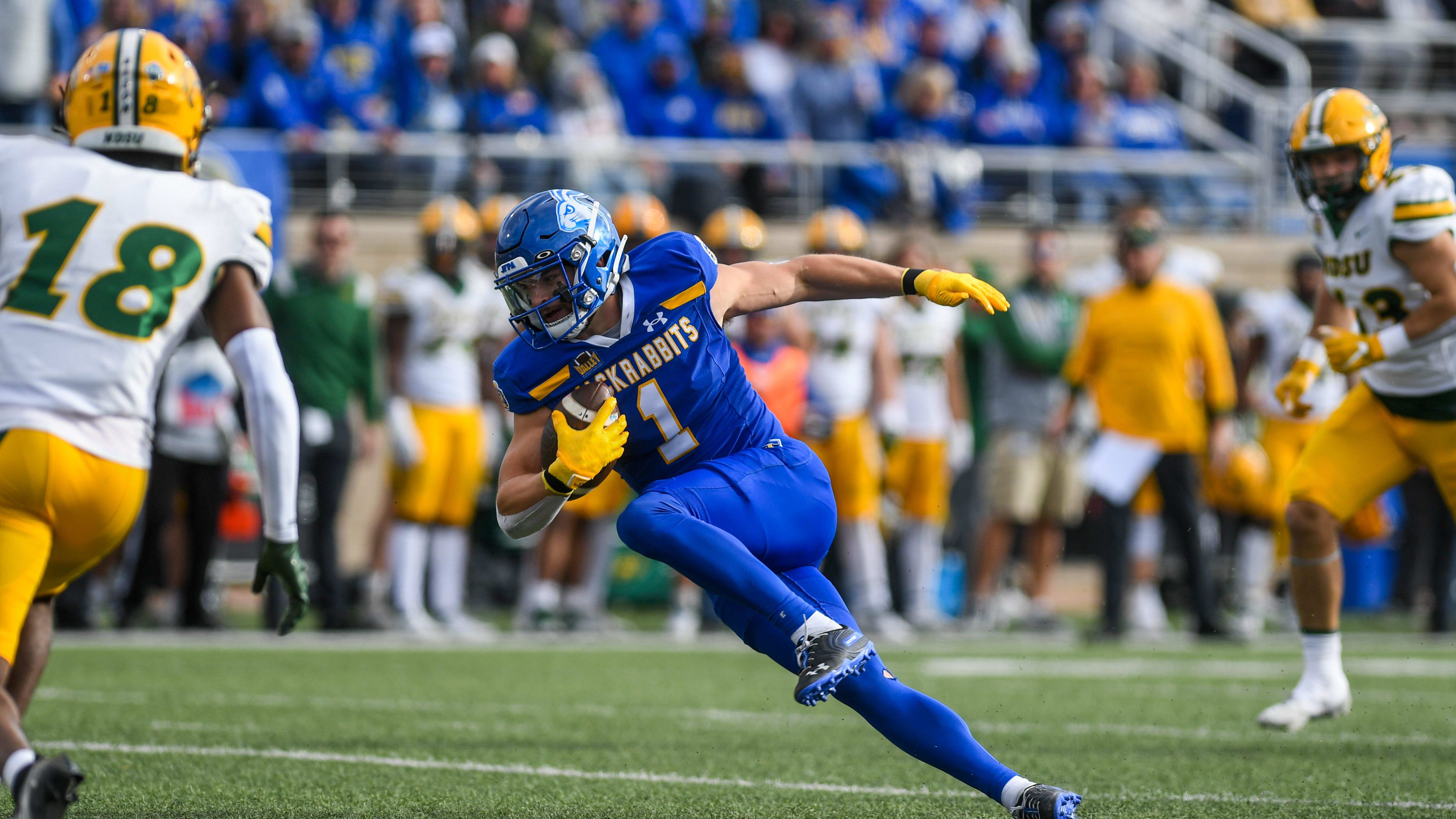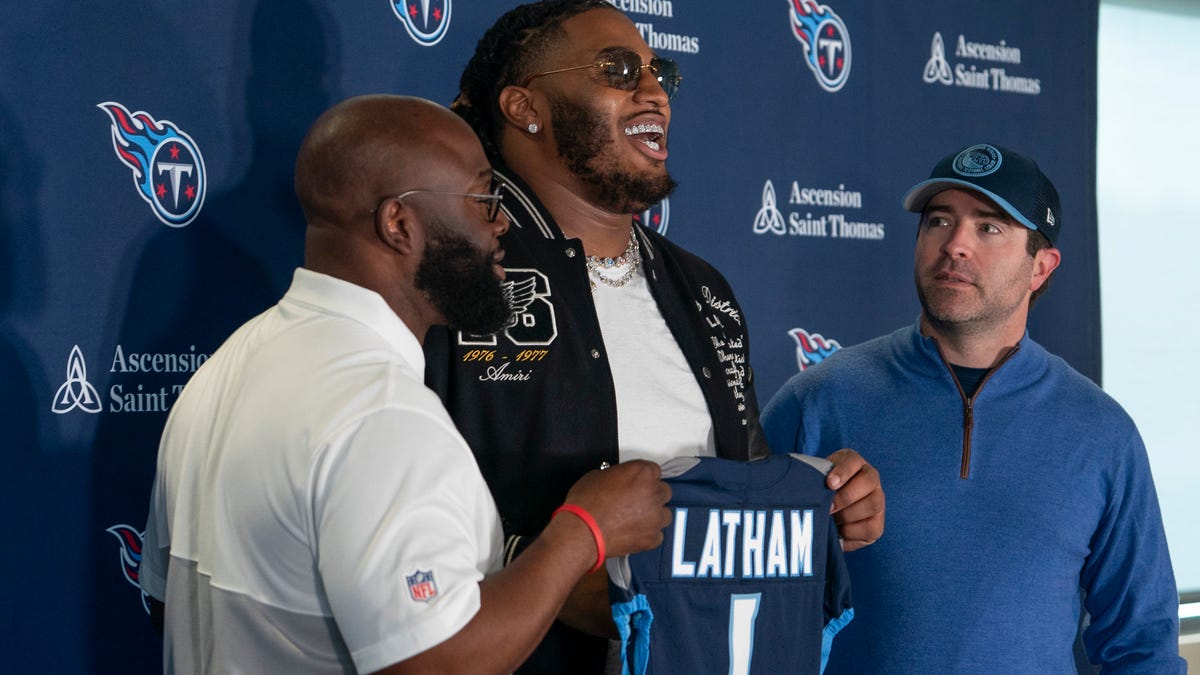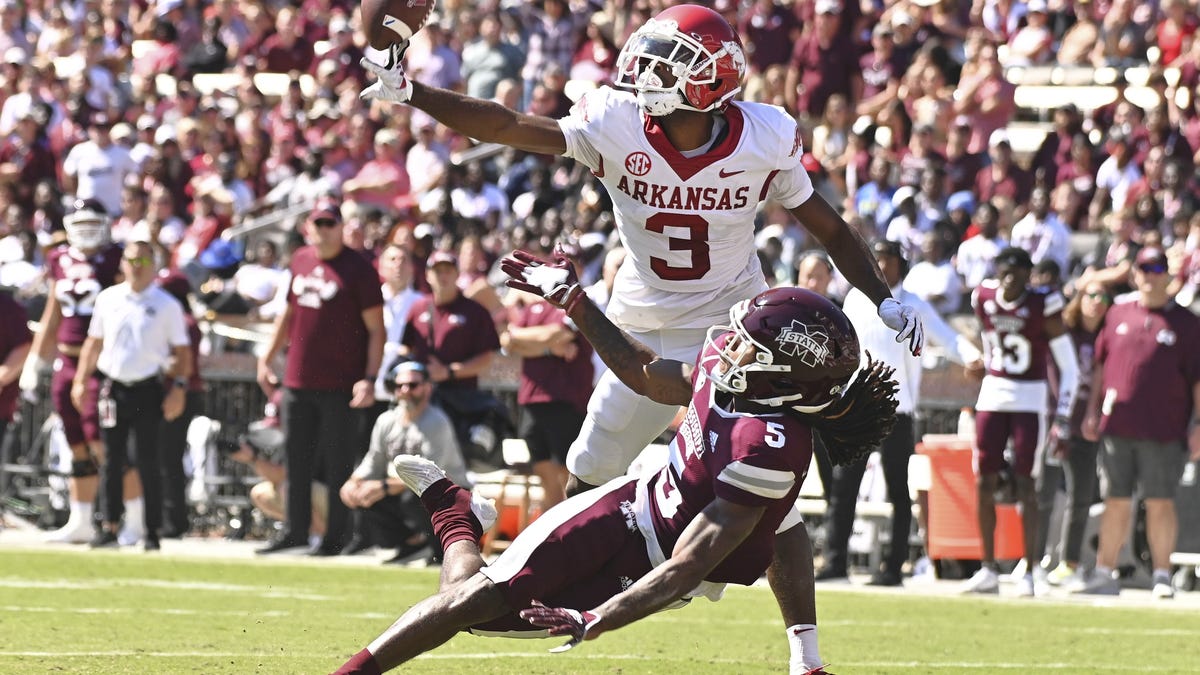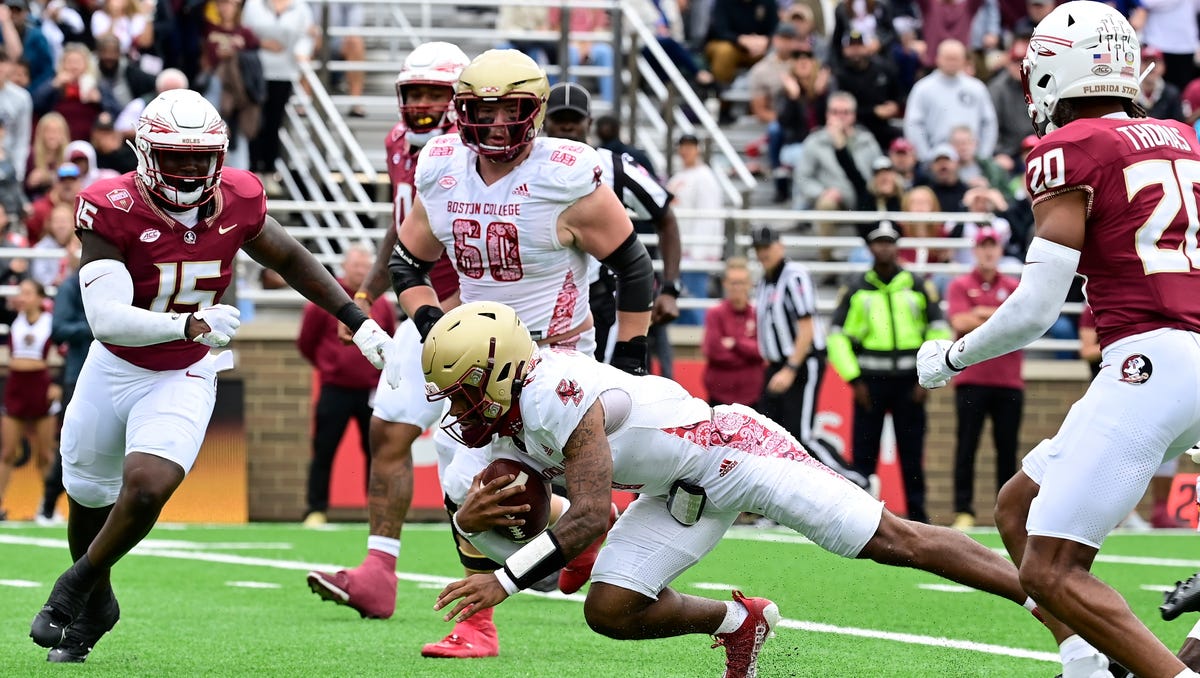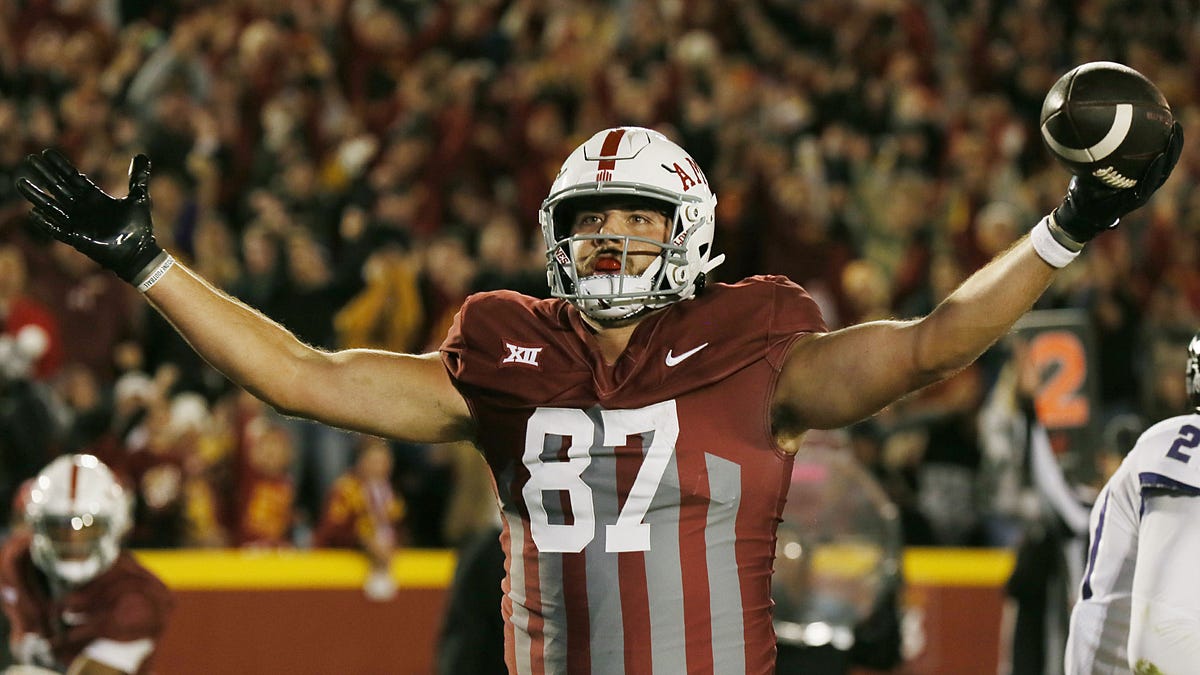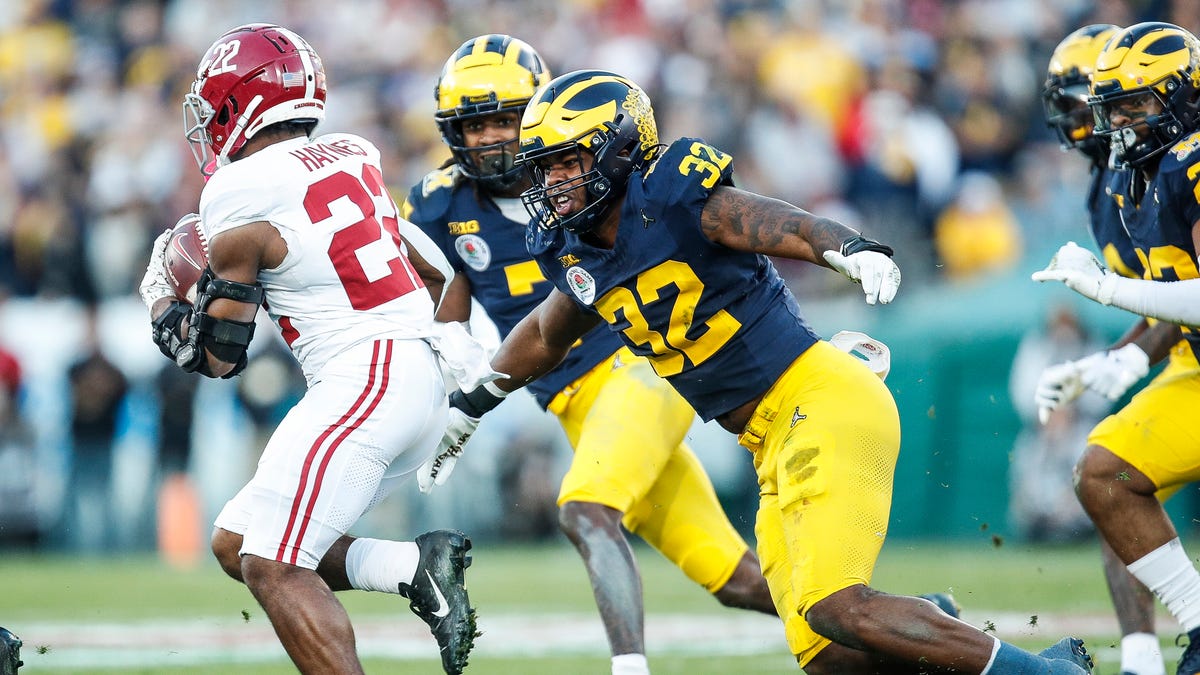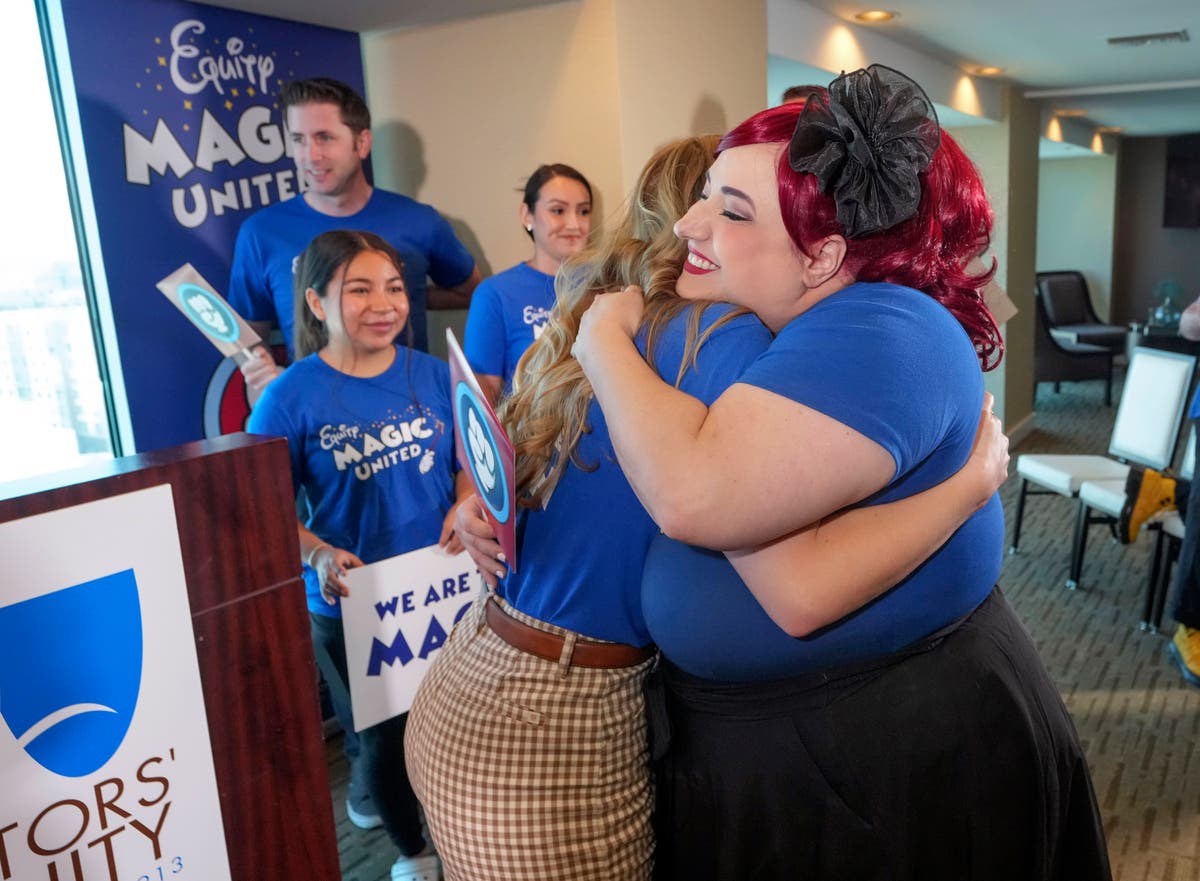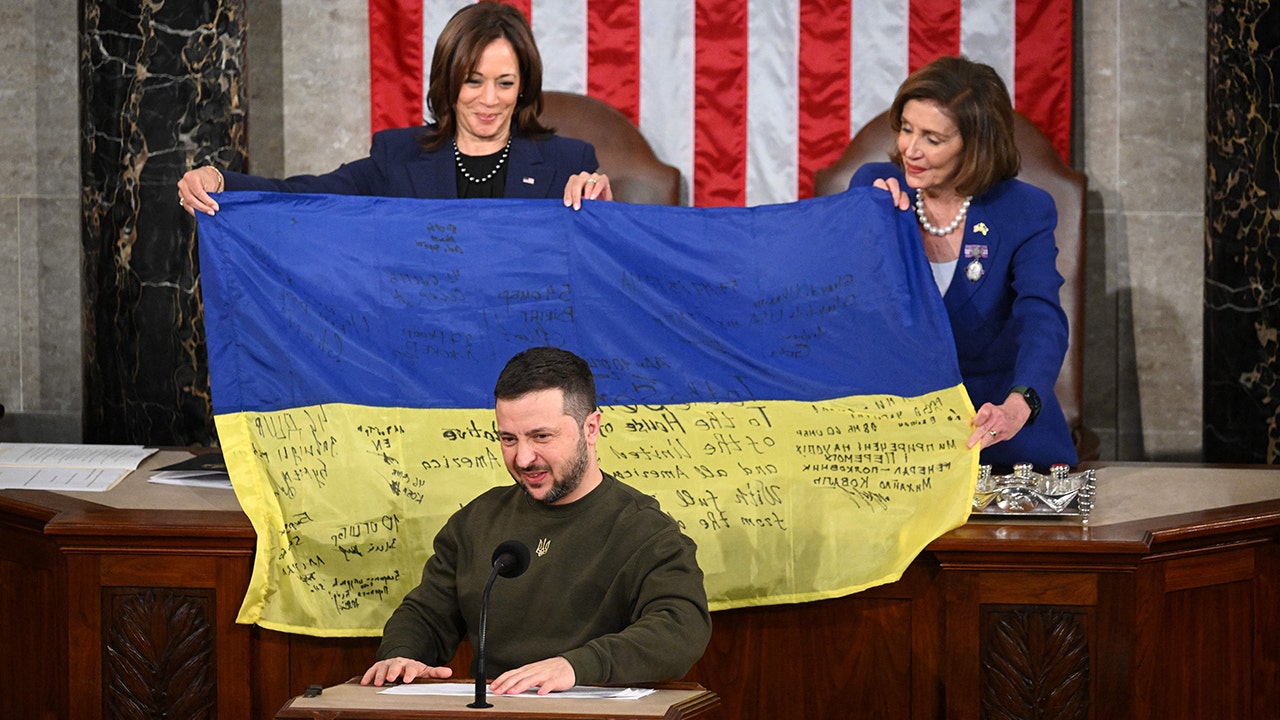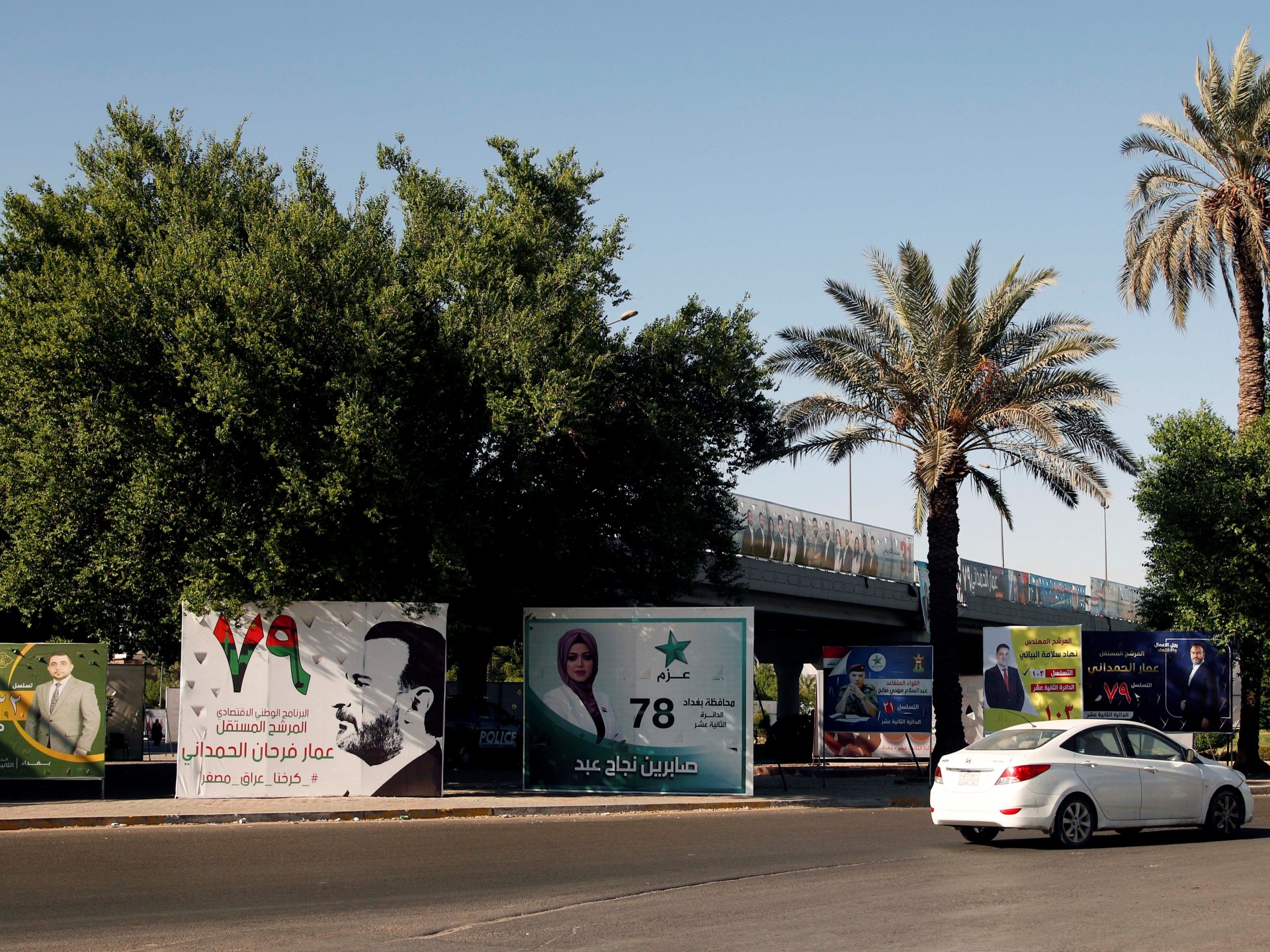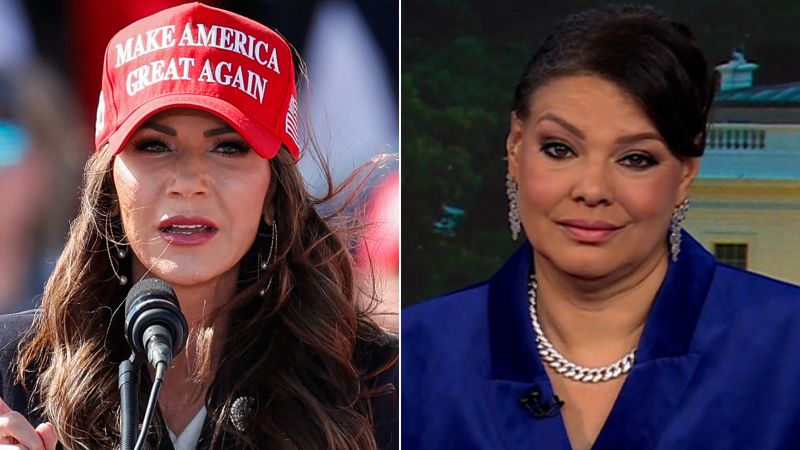Culture
NFL execs mock top 10: Jayden Daniels over Drake Maye? Marvin Harrison Jr. outside top 5?

One year ago, NFL executives emerged from the scouting combine thinking the Chicago Bears were open to trading the first pick in the draft. They were right. This year, sentiment from NFL front offices holds that the Bears will use the top pick, acquired from the Carolina Panthers one year ago next week, on USC quarterback Caleb Williams.
Checking in with decision-makers this time of year provides a snapshot of their expectations coming out of the combine. What they think might happen in early March evolves as the draft nears, partly because coaches become more involved in the process. But I find value in taking a snapshot to establish a baseline.
I’ve put together a rough top 10 based on conversations with six executives during and after the combine. Clear themes emerged for quarterbacks, offensive linemen and receivers, with some intrigue surrounding a QB prospect whom teams haven’t assessed as fully.
Last year, execs correctly projected seven of the top 10 players selected. Bijan Robinson, Jalen Carter and Darnell Wright were the three players landing in the actual top 10 without appearing in the March 2023 projection.
Execs narrowly missed on offensive lineman Peter Skoronski (Tennessee picked him 11th). They missed on cornerback Christian Gonzalez, who went 17th to New England. And they whiffed on quarterback Will Levis, who was not selected until the 33rd slot — a reminder that when QBs fall, they can plummet, because only a subset of teams will consider one early in a given year.
This year, the general theme was for quarterbacks to go first, then offensive linemen, then wide receivers, with some overlap between those two final positions. Only a couple of defensive players made the projected top 10.
We are not projecting potential trades below because there are too many possibilities. Finding logical homes for the highest-ranked players based on the order as it stands today captures the general feel at the moment.
Four players appeared in the top 10 on all six ballots: Caleb Williams, Jayden Daniels, Drake Maye and Joe Alt.
Five players appeared on five of six ballots: Dallas Turner, Marvin Harrison Jr., Rome Odunze, Olu Fashanu and Malik Nabers.
JC Latham appeared on four ballots. Jared Verse appeared on three. Brock Bowers appeared on two. Chop Robinson and Byron Murphy II each appeared on one.
The top 10 picks below have been formed from a consensus of the six ballots. Nabers and Latham were not selected in the top 10 because there was no consensus on where either would land, but they would be part of any consensus top 10 overall.
Most also thought J.J. McCarthy would be selected among the top 10, probably to a team that traded up, such as the Denver Broncos. But none of the six execs penciled him in for one of the teams already picking in the top 10, at least not yet.
GO DEEPER
2024 NFL Mock Draft: Trades shake up Round 1; QBs, WRs dominate early
1. Chicago Bears: Caleb Williams, QB, USC
Vote distribution: Williams 6
All six execs had the Bears selecting Williams and trading incumbent starter Justin Fields. All endorsed Chicago heading down this path.
“I would be evaluating the other quarterbacks like crazy right now and saying, ‘What if I moved down to two or three and got a historic return?’” one of the execs said. “Would I still be getting a franchise quarterback?”
The strongest concern voiced regarding Williams was his tendency to hold onto the ball longer than is ideal for a timing-based offense. In a worst-case scenario, that could lead to more third-and-long situations, robbing an offense of consistency. But the feeling among execs was that Chicago should not hesitate in making Williams the first selection.

GO DEEPER
Russini: What I’m hearing at the NFL combine on the Bears, Kirk Cousins and more
2. Washington Commanders: Jayden Daniels, QB, LSU
Vote distribution: Daniels 5, Maye 1
Five of six execs had Daniels heading to Washington in this slot. One of the five initially had Maye, then changed to Daniels a few days later.
“I think people struggle with Maye’s mechanics,” this exec said.
The one holdout for Maye in this slot said he heard Commanders general manager Adam Peters was “really into” Maye. The fit could be appealing. Maye and incumbent Commanders starter Sam Howell were teammates at North Carolina. Howell could open the 2024 season as the starter if the Commanders wanted to give Maye time to assimilate.
Another exec left open the possibility that Michigan’s McCarthy could compete with Daniels and Maye for this slot.
“If he throws well,” this exec said of McCarthy, “he is competing for the No. 2 spot. I don’t see him overtaking them, though.”
The Athletic’s Randy Mueller predicted months ago that McCarthy could rise into the top five as teams and specifically coaches learned more about him, before it was known whether McCarthy would enter the draft. Mueller, a three-time GM and one-time NFL Executive of the Year, also thinks analysts are overrating Maye based on prototypical size, and that some teams will not have Maye rated as highly.

GO DEEPER
Ten NFL Draft prospects to watch in bowl games: J.J. McCarthy’s big opportunity
“I think that whole quarterback thing between McCarthy and Maye is yet to play out,” a former GM said. “The other two I think are more set.”
For now, all six execs projected Maye being selected second or third.
“Could you say McCarthy could go in the top five? Yes,” the former GM said, “because everybody had him on the back burner this fall. And then Michigan was not centered around the quarterback like Oregon or Washington was, so he was not going to put up monster numbers. But then when you start looking at the talent and the makeup, he looks pretty good to people.”
Vote distribution: Maye 5, Daniels 1
Every exec had the Patriots selecting a quarterback in the first round. Maye was the choice more by default than because anyone thought New England was particularly high on him.
“I think they would probably rather have Jayden Daniels, but I’ll put Maye in there,” one exec said.
One GM whose team already has a franchise quarterback thought McCarthy would be “a huge reach” in this spot, but he conceded New England could make a bold selection with Eliot Wolf running the draft room.
“I think they go quarterback,” this GM said. “Do they take a shot at J.J.? Eliot won’t be afraid to if he believes in the player. Just look at what his dad has done.”
Ron Wolf famously acquired Brett Favre from the Atlanta Falcons three decades ago.
“Ron Wolf’s son is going to go for the biggest, fastest, most talented athlete in most cases,” a different exec said.
Vote distribution: Joe Alt 2, Dallas Turner 2, Marvin Harrison Jr. 2
There was zero consensus on Arizona in this slot. I gave Turner to the Cardinals because their defense badly needs reinforcements.
“Turner is squarely in the top 10 now,” one exec said, citing the Alabama product’s 4.46 in the 40-yard dash.

GO DEEPER
NFL combine standouts: Which QBs are rising? Who else helped their draft stock?
We could have sent Harrison or Alt to the Cardinals just the same.
“I think they have to go pass rush if they stay there,” one of the execs said. “It could be Dallas Turner. Verse might be a safer pick. I would think they will be looking to move down. There is enough rush, even a Chop Robinson, to get him lower. Seven (Titans) and six (Giants) could trade up for a tackle.”
Trading down from this spot makes perfect sense, perhaps regardless of how the top three picks play out.
“I would expect them to trade the pick,” one of the execs said. “Look at how they moved back last year, and then the fact that this is going to be an attractive spot because it allows someone to come up from a distance to get the player they want.”
This exec was picturing one of the quarterback-needy teams vaulting into this spot for McCarthy or Maye. The Cardinals have already committed to Kyler Murray as their quarterback. Moving back to, say, the 12th slot in a trade with Denver could still deliver the eighth-best non-quarterback in the draft for a team already set at the position.
“That is a perfect distance maybe for Arizona to go back, load up on picks, including a first next year, and there are still players there that are going to have equal opportunity to have a significant impact,” the exec said. “They could get the No. 1 corner, the No. 2 edge guy, still a good tackle, still a good receiver.”
Arizona has been a popular destination for Harrison in mock drafts. While four of the six execs projected Harrison to be the first receiver selected, Nabers and Odunze also got votes, and Harrison wasn’t necessarily seen as the best by a wide margin.
“I think they’ll take Marvin Harrison because I think he is the most talented, solid, all-the-way-around guy,” another exec said. “Let me put it to you this way: I see him being the best available player at that time. If you don’t look at him as better than Odunze or Nabers, then yeah, maybe you go with Alt or Dallas Turner. But they gotta keep giving their quarterback some players, too, and I think Marvin Harrison is going to check every box, and is more talented.”

Dallas Turner turned heads in Indianapolis with outstanding testing numbers. (Stacy Revere / Getty Images)
Vote distribution: Alt 2, Fashanu 2, Turner 1, Nabers 1
The first four execs polled sent an offensive lineman to the Chargers, figuring the pick would make sense symbolically for the team’s old-school coach, Jim Harbaugh. But there was some strong pushback against this idea as well, which we’ll get to in a moment.
“Joe Alt might be the safest and most complete of the tackles,” one exec said. “They have a left tackle. They could play him at right tackle. You are going to want to give the quarterback a run game, and then you are going to want to protect him for the first time in his career.”
Solid thinking, but is it solid value?
“That is one thing I just don’t get,” another exec said. “Taking a guy to play right tackle, I just don’t understand that. Alt is clean, and I love Alt, but with pass rushers, there is a big difference in the value of the position to me. We can find a right tackle.”
This exec penciled in Turner for the Chargers. Another leaned toward the offensive line initially but thought Nabers would make the greater impact.
“To get Herbert a guy like Nabers would give them some L.A. fireworks,” he said.
6. New York Giants: Marvin Harrison Jr., WR, Ohio State
Vote distribution: Harrison 2, Nabers 1, Odunze 1, Latham 1, Alt 1
Four of the six execs had the Giants selecting a receiver, but there wasn’t strong conviction regarding which receiver would be the choice, partly because the top three wideouts could go in just about any order.
An exec who sent Harrison to the Cardinals at No. 4 settled on Odunze for the Giants.
“Nabers is more speed, while Odunze is more possession, big, strong, physical,” this exec said. “They might go with Odunze just because they took the speed guy out of Tennessee (Jalin Hyatt) last year, and this would be a good complement.”
The Giants need help on their offensive line, but they’ve invested recent high draft choices in the position. The exec sending Latham to the Giants noted that the team seems to like SEC players. What about a quarterback?
“If you are the Giants and J.J. McCarthy is there, I think you have to take him,” one exec said. “That doesn’t mean they will do it. They desperately need offensive line. Let’s just give them Alt. I could see them saying, ‘If Jones doesn’t work this year, we will have another top 10 pick next year and worry about it then.’”
Vote distribution: Fashanu 2, Latham 1, Alt 1, Nabers 1, Verse 1
Four of the six execs sent an offensive lineman to the Titans.
“They have not replaced Taylor Lewan, and they need to do that,” one of the execs said. “The guy they took last year (Skoronski) was really a guard. They need a left tackle.”
The lone exec sending a defensive player to the Titans did so based on what he knows about Tennessee’s GM, Ran Carthon.
“I think they go with the best pass rusher,” this exec said. “Ran would probably rely on his 49er days, probably take Verse. I have not personally studied Verse and Turner enough to have a strong opinion, but that is my gut based on what I have seen.”
8. Atlanta Falcons: Jared Verse, Edge, Florida State
Vote distribution: Verse 2, Turner 2, Robinson 1, Latham 1
The execs generally thought the Falcons would address their quarterback situation in free agency or by trade, although one GM offered up another possibility.
“They are the most likely to trade to 1 and get Caleb Williams, or trade for Fields,” this GM said.
Adding young pass rush help for a veteran defense wouldn’t be as exciting. It could be the best option.
“You can’t take another offensive skill player, can you?” one of the execs said. “I don’t see a quarterback necessarily because I think they are going to sign Russell Wilson. They could go corner, too, but I’ll give them a pass rusher.”

GO DEEPER
Is Russell Wilson a Hall of Famer? Assessing his future, legacy after Broncos flameout
Another exec cautioned against ruling out a receiver, noting that the Falcons could still use help at the position. But he thought defense was more likely.
9. Chicago Bears: Rome Odunze, WR, Washington
Vote distribution: Odunze 3, Nabers 1, Harrison 1, Byron Murphy II 1
Odunze was the highest-rated receiver available in this scenario and a straightforward pick for a team that targeted its franchise quarterback at the top of the draft. The Bears also could find a defensive player for their defensive-minded coach, Matt Eberflus, under the thinking that Williams would unlock more from their receivers, led by DJ Moore.
“To pair Caleb with a top-tier receiver, both of them young, both with a lot of time, yeah, it would be really hard not to do that,” one exec said.
10. New York Jets: Brock Bowers, TE, Georgia
Vote distribution: Bowers 2, Nabers 1, Odunze 1, Fashanu 1, Latham 1
None of the execs thought selecting a tight end in this slot would be a sound move.
“When you are picking in the top 10 and you need offensive line help and you take a tight end, that is malpractice,” the exec sending Fashanu to the Jets said. “You can’t do that. That is just ridiculous.”
Another exec said the Jets needed to select a tackle in this slot, or trade back and select one. But he didn’t necessarily think the Jets would do that.
“It is hard in the top 10 to not take a building-block position, but the Jets are in a unique spot because they have to win this year or they don’t have jobs,” this exec said. “You are getting weapons for Aaron Rodgers and he is going to scheme it for you. They have swung and missed on so many offensive linemen. I would think they go offensive line in free agency.”

GO DEEPER
NFL execs mock top 10: Jayden Daniels over Drake Maye? Marvin Harrison Jr. outside top 5?
(Top photos of, Drake Maye, left, and Jayden Daniels: Grant Halverson, Jonathan Bachman / Getty Images)

The story of the greatest players in NFL history. In 100 riveting profiles, top football writers justify their selections and uncover the history of the NFL in the process.
The story of the greatest players in NFL history.
Buy

Culture
NFL Draft 2024 Round 1 grades: Falcons, Broncos get Cs for Penix, Nix; Bears earn two A's

Welcome to The Athletic’s pick-by-pick grades for Round 1 of the 2024 NFL Draft. We broke down every selection as the drama unfolded throughout Thursday night. Which teams found the prospect (or prospects) they needed? Who might regret their decision down the line?
Of course, we won’t have full, accurate answers to those questions for a few seasons, so our grades tried to take everything into account — pick value, trade costs, what the board looked like at the time of the selection and so on.
Here’s how everyone did:
(Note: Scott Dochterman provided grades for odd-numbered picks, Nick Baumgardner for even-numbered picks.)
NFL Draft 2024 tracker: Live blog, pick-by-pick grades and analysis
Big board best available: Who’s left from Dane Brugler’s Top 300?
Full draft order: Team picks for all 257 selections
“The Athletic Football Show”: Watch live reaction to the draft
There was only one rational path for the Bears to take, and they took it. With the top pick and a shot at Williams in hand, the Bears practically gave away well-liked former first-rounder Justin Fields earlier this offseason. This selection is the right choice at the right time for a franchise that hasn’t had a starting Pro Bowl quarterback since Sid Luckman in 1942. In short order, Williams (6-foot-1, 214 pounds) could be just the third Pro Bowl QB overall for the Bears in the Super Bowl era.
The 2022 Heisman Trophy winner can lead in multiple ways and make every throw from any position, including on the run. He didn’t throw an interception on third or fourth down during his USC career and is seemingly in control in tight situations. He does need to work on fumbling issues (33 overall and 16 lost during his college career, counting his first season at Oklahoma).
Grade: A
GO DEEPER
NFL Draft 2024 ‘The Beast’ Guide: Dane Brugler’s scouting reports and player rankings
It’s a new day in Washington D.C., now complete with a new QB. The 2023 Heisman Trophy winner, Daniels threw for 57 touchdowns to just seven picks in two years with the Tigers. He was one of the most improved players in the country during that stretch, too. An electric dual-threat passer with elite speed and short-area quicks in space, Daniels is unique and built for the modern game.
Some had Daniels a bit behind Drake Maye, though Daniels was worthy of a top-five choice this year. He has to be better against pressure and show he can throw inside the numbers, but he’s a serious playmaker who knows how to lead and brings with him a terrific work ethic.
Grade: A
The Patriots had options to trade down and perhaps stockpile talent at other positions, but their need at quarterback was greater. It’s a risk for New England, which couldn’t turn Mac Jones into a success, but it’s the right one.
When one looks at Maye (6-4, 223), they can see a carbon copy of the prototypical quarterback. There’s no question he has every tangible quality NFL personnel seek at the position, and his intangible gifts are obvious, as well. But his career trajectory will tilt upward if he can slow down a bit and make all of the plays. That’s going to require patience from the Patriots’ front office, coaches and players — and from Maye himself.
Considering his potential, Maye may have the most upside of any quarterback in the draft. That’s worth betting on.
Grade: A
The Cardinals have more capital to work with in this draft than any other team, and GM Monti Ossenfort gets things started with a bang by adding a great new friend for Kyler Murray. Harrison is arguably the most complete receiver prospect we’ve seen in a decade, with no true holes in his game. His ability to adjust to off-target throws — deep and underneath — is unmatched in this class.
A trade down definitely could’ve made Arizona’s draft haul even greater, but the Cardinals needed a wide receiver. There’s nothing wrong with sticking and taking the best player at an area of need. Great pick, and possibly an elite one.
Grade: A
Jim Harbaugh built Michigan into a national champion by fortifying its offensive line. He now will attempt to do the same with the Chargers. Harbaugh had plenty of opportunities to trade down, but starting his tenure with an elite left tackle was too much to discard.
After beginning his career as a tight end, Alt slid to left tackle midway through his freshman year at Notre Dame and never vacated the position, making 33 consecutive starts. He has the requisite arm length (34 1/4 inches), quickness (1.73-second 10-yard split), strength and natural ability to play left tackle for a decade-plus in the NFL. His father, John Alt, was a stalwart left tackle with the Kansas City Chiefs in the 1980s and 1990s.
Grade: A-minus
Nabers is an electric playmaker and arguably this class’ most dangerous ball carrier in space. An incredibly smooth and explosive athlete with great ball skills, Nabers was an instant contributor in the SEC for LSU and made 161 catches (playing with Jayden Daniels) the last two seasons. There were some scouts who had Nabers ranked ahead of Harrison — he’s that good.
The Giants have questions about Daniel Jones, to be sure. But they still have so much work to do that bringing a first-round QB in to compete for the job wouldn’t have made much sense. Nabers is an awesome talent and will instantly make one of the slowest offenses faster. This is a sensible, efficient and potentially explosive draft pick.
Grade: A
Most receptions of 20+ yards over the last 5 years in CFB:
34 – Malik Nabers (2023), Ja’Marr Chase (2019)
33 – Jordan Addison (2021)
32
31
30 – DeVonta Smith (2020)
29
28
27
26 – Rome Odunze (2023), CeeDee Lamb (2019) pic.twitter.com/oGF9RR8ohY— Dane Brugler (@dpbrugler) December 1, 2023
Tennessee absolutely needed a tackle as part of its offensive line reconstruction, and Latham has the potential to become an anchor for a decade. But is this the right spot for him? He was a right tackle at Alabama, and the Titans have a glaring need at left tackle. If Latham can make that move, it’s perfect. If not, this becomes a question mark.
Perhaps the most powerful player in the draft, Latham caves in defenses when run blocking. He’s massive (6-5 1/2, 342) with an 85-inch wingspan and 35-inch arms. A second-team All-American last fall, Latham didn’t miss a game and made 27 consecutive starts at Alabama.
Grade: B
And we’ve found our first stunner. Months after signing Kirk Cousins to a four-year deal worth up to $180 million, the Falcons go quarterback — and not J.J. McCarthy. Instead, it’s Penix, the nearly 24-year-old lefty. This is beyond interesting and, for Cousins, perhaps feels like a bit of deja vu from his days alongside Robert Griffin III.
Penix is a talented passer, to be sure. But there are questions here: his age, his health (he’s had multiple leg injuries), his consistency as an accurate passer and the fact Cousins is making a fortune. Penix doesn’t throw the ball over the middle with nearly the same confidence he shows outside the numbers. He’s going to have to figure out better answers versus pressure.
But his arm talent is outstanding, and it’s hard to bet against his perseverance. At No. 8, though? This feels a reach. Time will tell.
Grade: C
The Falcons took Michael Penix Jr. with the No. 8 overall pick.
The crew reacts on The Athletic’s live Draft show: https://t.co/cHhKHwelvy pic.twitter.com/eI1PqP2Jbb
— The Athletic NFL (@TheAthleticNFL) April 26, 2024
9. Chicago Bears: Rome Odunze, WR, Washington
The Bears have remade their offense in two short years, and by selecting Odunze after getting Williams at No. 1, Chicago may have changed the trajectory of its franchise for perhaps the next decade. With Odunze, Keenan Allen and DJ Moore working with Williams, the Bears have a potentially explosive offense. (Yes, let that sink in.)
The FBS leader in receiving yards last year (1,640), Odunze (6-3, 212) has great size and length that eventually should lead to him playing X receiver. He’s fast and explosive (32 catches of 20-plus yards last year). With very good speed (4.45-second 40-yard dash) and a wide catch radius, Odunze can make big plays down the field in contested situations.
In most drafts, he’d be the top receiver chosen and among the favorites for Offensive Rookie of the Year.
Grade: A-plus
What an offseason for the Vikings. After making a big pre-draft move, Minnesota was able to land a quarterback (and climb one spot) without surrendering its other first-round pick. (The Vikings sent Nos. 11, 129 and 157 to the Jets for this spot and No. 203.) All this mere months after Minnesota lost Cousins, its previous franchise QB.
McCarthy’s skill set has had NFL evaluators on alert for three years, though his work inside Michigan’s run-heavy offense made it very difficult to totally project what he’ll be immediately in the NFL. A very tough, aggressive passer in the mold of his former coach (Harbaugh), McCarthy’s an unquestioned winner (63-3 record since high school).
He may need to learn behind Sam Darnold for a minute, but this is a great long-term fit with Kevin O’Connell — and he could be more ready early on than some believe.
Grade: A
11. New York Jets (from MIN): Olu Fashanu, OT, Penn State
In the debate between need and want, the Jets went with the latter, and in doing so laid a foundation for the future up front. Fashanu likely will get thrown in as a rookie and could become an anchor for the next decade. As tempting as tight end Brock Bowers had to be here, the Jets made the right move. Fashanu is a left tackle, and that’s important for the Jets’ future.
Massive and explosive, Fashanu was a force for the Penn State offensive line the last two seasons. He considered leaving for the NFL after the 2022 season but chose to return and became a consensus All-American, the Big Ten’s Offensive Lineman of the Year and a finalist for the Campbell Trophy (the “Academic Heisman”).
Grade: A
The 2024 quarterback thirst is very real. Make it six QBs gone in the top 12.
This one, somehow, didn’t feel as shocking as the Penix pick — in part because that already happened. There’s a lot to like about Nix. In fact, the conversation surrounding the former Oregon passer is very similar to the one about Penix: He’s older and comes with physical limitations. Unlike Penix, though, Nix played in a very college-style offense at Oregon.
But Sean Payton knows quarterbacks, and Denver can’t go anywhere without one. The fit here does work, as Nix’s quick release and poise should fit pretty well with Payton’s scheme. Still, as with the Penix pick, it sure feels like Denver could’ve gotten more value here. It’s a bold move, if nothing else.
Grade: C-plus
To justify this pick, you have to think of Bowers as a pass catcher, not strictly as a tight end. When you consider that his versatility will allow him to play alongside last year’s second-round tight end, Michael Mayer, then it could be a major coup. The Raiders will need to work heavily out of 12 personnel to make this fit. It’s a great value, but did Bowers fill a need?
That said, Bowers is a steal at this point. The first two-time Mackey Award winner as the nation’s top tight end, Bowers is a mismatch wherever he lines up — inline, slot, backfield or out wide. Few pass catchers find a way to get open like he does, and his 8.5 yards-after-catch average over his three seasons at Georgia is a rare number for his position. He was the best player on the field every time he stepped on it.
Grade: B-plus
The rush on quarterbacks really helped out a lot of teams in the back half of Round 1. It helped the Saints here, in a big way. Fuaga was a top-two tackle on some NFL boards, top-three on several more. And there wasn’t a team in the league more in need of tackle help than the Saints, who just landed a road grader.
Fuaga (6-5, 324) was dominant at times on the Beavers’ right side last season, as arguably the best run blocker in the country. This is a culture pick as much as anything else, too — Fuaga will help improve the team’s overall toughness up front. Great value for the Saints in the middle of the first round.
Grade: A
It took 15 picks, but Indianapolis finally selected this draft’s first defensive player. And the Colts got a good one in Latu, who might have been the best defensive player in college football last season (13.0 sacks, 21.5 tackles for loss). Indianapolis, meanwhile, ranked 28th in scoring defense, 24th in run defense and allowed 22 rushing touchdowns.
Latu should help in every area, and he’ll also entere the NFL as one of its best stories. His NFL dream nearly was derailed by a neck injury in 2020, which caused him to miss two seasons and led him to medically retire while at Washington; he was cleared to play again after surgery, then transferred to UCLA in 2022.
The only question is whether a cornerback might have been a more impactful pick, but Latu is a keeper.
Grade: B-plus

GO DEEPER
How star OLB Laiatu Latu masters the unique craft of pass rushing — and why
Good things come to those who wait? Sure, we’ll go with that. The Seahawks have had a need right in the middle of their defense for what seems like several years now. And after early runs on quarterbacks and tackles pushed the top defenders down, Seattle hit a whopper by landing the top interior defensive lineman in this draft.
Murphy, who can play nose or three-tech, is extremely powerful and explosive with a lethal punch at the point of attack. A smaller body in the Aaron Donald mold, Murphy is all gas off the line of scrimmage, and his natural leverage makes him a bear to deal with inside. Some teams valued him as a top-10 prospect in this draft. This is terrific value for new Seattle head coach Mike Macdonald.
Grade: A
17. Minnesota Vikings (from JAX): Dallas Turner, Edge, Alabama
After losing Danielle Hunter in free agency, the Vikings needed some pass-rush punch. So, Minnesota jumped up six spots (sending Nos. 23 and 167 plus third- and fourth-round picks in 2025 to Jacksonville) and grabbed perhaps the draft’s most athletic pass rusher. Turner was considered by many to be a possible top-10 pick. Edge was a need for the Vikings, too, probably equal to cornerback.
Turner (6-2, 247) was a consensus first-team All-American last season after posting 11.0 sacks, 15.5 tackles for loss and two forced fumbles. He solidified his first-round status with an impressive combine (4.46 40-yard dash, 40 1/2-inch vertical, 34 3/8-inch arms). He should replace Hunter quite nicely.
Grade: A
Mims might be the freakiest athlete in the entire draft. The 6-7, 340-pounder has 36 1/8-inch arms, a near 87-inch wingspan and 11 1/4-inch hands. He’s simply a massive human. He also runs like a tight end and can deliver a punch that will decleat anybody. His ceiling is more or less out of this world.
His floor, however? That’s another conversation. Mims started just eight games over three years at Georgia, missing six last year with an ankle injury. A right tackle only in college, Mims still makes a ton of youthful mistakes with his eyes and feet and will fall off blocks far too easily. However, with time in an NFL system and the right offensive line coach, he could develop into a true star.
Grade: B-plus
The Rams lost Aaron Donald, one of the greatest defensive linemen in NFL history, and needed to find some way to replace him. Verse likely won’t equal what Donald brought (nor would anyone else), but he was a nice choice for a team that hadn’t made a first-round pick since 2016. Chop Robinson might be more explosive with a higher upside, but Verse was more productive in college.
A workmanlike technician with a motor, Verse (6-4, 254) became an All-American after beginning his career at Albany as a no-star recruit. He played three seasons in the FCS (including one as a redshirt), then transferred to Florida State and posted back-to-back nine-sack seasons. Although he may not wow observers physically, Verse boasts one of this class’ top work ethics, which will serve him well in the NFL.
Grade: B
FSU’s Jared Verse just had the best two-game stretch of his career the last two weeks vs. Florida and Louisville. Dominated both games.
17 pressures, 6.0 TFL, 4.5 sacks, 1 FF pic.twitter.com/fu0hdyRCX9
— Dane Brugler (@dpbrugler) December 3, 2023
One of the most versatile linemen in this draft, Fautanu is bit oddly shaped for his position — in a good way. At 6-3, 317, Fautanu plays low to the ground but also has great length (34 1/2-inch arms). A left tackle at Washington, Fautanu is athletic and a possible five-position prospect. The Steelers announced him as a tackle, but he also could play guard and maybe even center.
The Steelers need help in the middle of their offensive line, so it won’t be a shock if he gets a shot there. If that doesn’t work out, though, he could play opposite Broderick Jones or inside at guard. This is a great pick and an outstanding value.
Grade: A
With both of its starting edge rushers (Jaelan Phillips and Bradley Chubb) coming back from season-ending injuries, Miami needed reinforcements, even if just to rotate. The Dolphins picked up perhaps the best player available, and one with plenty of upside. They could have used an offensive lineman, but an earlier run at that position helped nudge them toward Robinson.
One of the most feared pass rushers in the Big Ten, Robinson commanded attention last year on Penn State’s elite defense. He picked up just four sacks and 7.5 tackles for loss in 10 games, but he was regularly double teamed in passing situations. The 6-3, 254-pounder has elite get-off at the line of scrimmage, which was validated by his 4.48 40 at the combine.
Grade: B-plus
Many wondered if Philadelphia might move up to address its obvious need at corner. Instead, with six quarterbacks going in the top 12, the corners fell to the Eagles.
One of the humblest players in the draft, Mitchell turned down big NIL money offered by SEC schools to stay at Toledo and finish his degree. As a player, he’s big, long and extremely fast — Mitchell burned a 4.33 at the combine, posted a 38-inch vertical and a broad jump of 10 feet, 2 inches, and was downright dominant at the Senior Bowl. He improved every day at Toledo and wound up with a whopping 52 passes defended over three years.
For Philadelphia, this couldn’t have gone better.
Grade: A

GO DEEPER
NFL Draft’s quiet star was built for this moment — and he’s rising up draft boards
After losing receiver Calvin Ridley in free agency, the Jaguars needed a replacement who could stretch the field and develop into a No. 1 option for quarterback Trevor Lawrence. Thomas might cover both needs. He’s got tremendous athletic ability and is capable of catching double-digit touchdown passes as a rookie.
At LSU, playing alongside Nabers, Thomas (6-3, 209) was a third-team All-American and led the country in touchdown catches (17) last season, while posting 68 receptions for 1,177 yards (17.3 yards per catch). At the combine, he ran a 4.33 40, the second-fastest time among all receivers.
Grade: A-minus
The hometown fans were concerned that the Lions might trade out of the first round. But as the corners started falling Thursday night, GM Brad Holmes couldn’t help but pick up the phone. Detroit moved up five spots (sending Nos. 29 and 73 to Dallas for No. 24 and a 2025 seventh-round pick) and filled a big need.
Like the Eagles, the Lions landed outstanding value in the 20s — Arnold and Mitchell were pretty clearly the top two corners in this draft. For Detroit, this was also a perfect fit for the team’s established culture. Arnold is a confident corner who plays with swagger, loves to work, loves tough coaching and loves to win. Arnold will reunite with former Alabama teammate Brian Branch in a new-look Detroit secondary. Another great value pick.
Grade: A
The Packers had needs both along their offensive line and in the secondary. They opted for Morgan rather than addressing that secondary, which intercepted a league-low seven passes last season. Morgan certainly is a first-round prospect, but Green Bay missed a chance to improve at its most vulnerable spot.
Largely considered a guard, Morgan (6-5, 311) started 37 games over five seasons at Arizona. His arm length (32 7/8 inches) probably will keep him inside, but he could kick outside, if necessary. He should be able to start right away at right guard.
Grade: C
Up there with Fautanu among the most versatile linemen in this class, Barton gained college starting experience at both center and tackle. He’ll most likely get a shot inside with the Buccaneers, who announced him as a center (and are in need of a center) but also could use a boost at guard.
One of the most powerful linemen in the class, Barton doesn’t have ideal length to play outside in the NFL. His power and IQ (along with his feet) are more than enough to be terrific inside, though.. He’s probably an interior-only lineman in the NFL, but he has a chance to be very good for a long time.
Grade: A-minus
27. Arizona Cardinals: Darius Robinson, Edge, Missouri
The Cardinals ranked last in run defense, 31st in scoring defense and allowed 4.7 yards per carry last season. They needed a talent infusion along their defensive line, and Robinson should provide it, likely as a 3-4 defensive end.
The best word to describe Robinson is “massive.” With a frame that could lead him to an edge or interior role, Robinson (6-5, 285) has positional flexibility up and down the line. He also boasts an extraordinary wingspan (84 3/8 inches) and incredible hand size (10 5/8 inches). At Missouri, Robinson was productive (8.5 sacks and 14 tackles for loss) and earned first-team All-SEC honors. He also was considered the leader on a team that beat Ohio State in the Cotton Bowl, and he was voted the practice player of the week at the Senior Bowl.
Grade: A-minus
Welcome to the Darius Robinson show.
Efficient arm-over vs. Tyler Guyton. pic.twitter.com/KM3VMUEDVJ
— Dane Brugler (@dpbrugler) January 31, 2024
28. Kansas City Chiefs (from BUF): Xavier Worthy, WR, Texas
Patrick Mahomes has yet to meet a player he can overthrow. We’ll see if Worthy gives him a run for his money.
The Chiefs moved up from the end of Round 1 — sending picks 32, 95 and 221 to Buffalo for Nos. 28, 133 and 248 — and snagged the fastest player in this draft. (Worthy set the combine record with a 4.21-second 40 earlier this spring.) This feels like a very good fit for Kansas City’s offense, and for Mahomes in particular, as Worthy is dynamic with the ball in his hands.
However, he’s also very small, at just 165 pounds. Whether or not he’ll be able to hold up with a high catch volume deep into a season is a fair question. Worthy can be inconsistent with his hands, too, and his play strength will limit some of what he can do a the next level. Was he a first-round prospect in this draft, especially with some of the talent still on the board? Maybe. But it’s tough to hate the fit.
Grade: B
“If he hits, he’s DeSean Jackson. But that’s a big if.”@dpbrugler on Patrick Mahomes’ newest weapon Xavier Worthy 👀https://t.co/cHhKHwelvy pic.twitter.com/I6zjfitmp7
— The Athletic NFL (@TheAthleticNFL) April 26, 2024
Dallas had big holes at two spots, center and right tackle, and filled the one on the outside here. It’s an upside move, as Guyton could start at right tackle and perhaps flip to left tackle in time. If he reaches his potential, he could form a solid tandem with Tyler Smith.
Still raw and developing, Guyton started 14 games at Oklahoma — 13 at right tackle, one at left tackle — before declaring for the draft. He also started one game as a tight end at TCU in 2021. Guyton (6-7 1/2, 322) has the requisite body for an NFL tackle (34 1/8-inch arms). It might take him some time, but his upside is immense.
Grade: B
One of the fastest players on the board (4.28 40 at the combine), Wiggins is quick off the line of scrimmage and also possesses excellent second-level speed — a combination that makes him incredibly difficult to beat vertically. Wiggins’ length (6-1 with almost 31-inch arms) is also a plus. He got his hands on a combined 25 passes over the last two seasons at Clemson.
The question marks here are size and power. Wiggins weighed 173 pounds at the combine, before checking in at a reported 182 pounds at his pro day. He was mainly an outside-only corner in college, and it remains to be seen how much he can give the Ravens against the run. He’s a first-round talent in this draft, though, to be sure.
Grade: A-minus
This feels like either a reach or an insurance policy, in case Brandon Aiyuk ends up getting dealt. Pearsall will make some tough catches and could wind up running plenty of interior routes alongside tight end George Kittle.
A five-year veteran who spent three seasons at Arizona State and two at Florida, Pearsall (6-1, 189) built a reputation for his toughness and ability to haul in difficult catches. Last year with the Gators, Pearsall caught 65 balls for 965 yards (14.8 yards per catch) and four scores. As a junior, Pearsall averaged 20.0 yards per catch (33-661) with five scores. He also ran a 4.41 40 at the combine and had a 42-inch vertical jump.
Grade: B-minus
The Panthers moved up one spot (picks 33 and 141 to Buffalo for Nos. 32 and 200) to snag help for QB Bryce Young. A 6-1, 221-pounder with a 40-inch vertical, Legette is a powerful blend of speed (4.39 40) and explosion. He looks and runs a lot like Seattle star DK Metcalf.
There are concerns, however. Before his breakout 2023 season (71 catches for 1,255 yards and seven touchdowns), Legette had a combined 42 receptions over his previous four years. He’s also 23 years old and not yet a consistent route runner. But he is a credible deep threat who will provide help as a returner. Would Texas’ Adonai Mitchell or Georgia’s Ladd McConkey have been a better option here?
Grade: C-plus
(Illustration: Eamonn Dalton / The Athletic; Photo of Michael Penix Jr.: CFP / Getty Images)
Culture
Cousins stunned Falcons drafted Penix Jr. in first round

The Atlanta Falcons made a surprising selection taking former Washington quarterback Michael Penix Jr. with the No. 8 pick in the 2024 NFL Draft.
Among those shocked by the selection was their current projected starting quarterback, Kirk Cousins.
The Falcons called Cousins when they were on the clock to let him know they were taking Penix, his agent, Mike McCartney, told The Athletic. When Cousins signed with the team this offseason, the Falcons told him they would be drafting a quarterback in the later rounds of this draft. He was stunned when they took one in the first round, and Cousins’ biggest concern is that the pick doesn’t help the team for the upcoming season.
Part of the reason Atlanta selected Penix is that it believes it won’t have a top pick in coming drafts with Cousins under center the next few years, a team source told The Athletic.
The Falcons signed Cousins this offseason to a four-year deal worth $180 million, including $100 million guaranteed. The 35-year-old quarterback is recovering from the torn Achilles tendon he sustained in Week 8 last season. Cousins said at his introductory news conference in March that he could take drops and make passes, but if added, “I think the minute I would have to leave the pocket is where you’d say, ‘Yeah, he’s still recovering from an Achilles.’”
Opinions varied on Penix
I didn’t think the Falcons would use the eighth pick for Penix, that’s for sure, but I do think Penix was a really interesting prospect in this draft.
Two former head coaches with strong track records were among the people I spoke with during the draft process who had Penix as their No. 2 quarterback in this draft, behind Caleb Williams. It seemed like very few people agreed with this assessment.
My feel during Super Bowl week was that Penix would be gone by the middle of the first round, but the recent chatter surrounding him made me feel like that was a stretch. With quarterbacks, there can be great volatility. If a team loves one, the team should take him. And when teams feel set at the position already, they simply do not select them most of the time. That is how someone like Penix can go earlier than expected while an Aaron Rodgers waits longer than expected. — Mike Sando, National NFL writer
Required reading
(Photo: Jorge Lemus / NurPhoto via Getty Images)
Culture
Concerns over fans' U.S. visa wait times for 2026 World Cup: 'Your window might already be closed'

Concerns have been raised with the United States government, including an official meeting in the White House, over fears supporters may be deterred from the 2026 men’s World Cup owing to excessive wait times to process visa applications to visit the country.
The tournament begins in 777 days and it will be at least another 18 months before many countries will be assured of qualification, yet the wait times for U.S. visa interviews in two Mexican cities are already in excess of 800 days, while it is 685 days in the Colombian capital of Bogota.
In a statement to The Athletic, the U.S. Department of State (which oversees international relations) insisted it is determined to reduce wait times but also encouraged supporters in affected countries to start applying for visas now, over two years out from the tournament and with the line-up still unknown.
The 2026 edition of world football’s governing body FIFA’s flagship tournament will include 48 nations for the first time and will be held in 16 cities in the U.S, Canada and Mexico.
It will also be the first World Cup without an overarching local organising committee, which means FIFA is tasked with pulling everything together, in conjunction with the many layers of stakeholders and bureaucracy across three nations and 16 host cities, each of which have differing levels of private and taxpayer support.
The three host countries also have differing entry criteria for visitors, which has the potential to create visa confusion for fans seeking to follow their team deep into the tournament across multiple borders.
Several host cities, including the location for the final — New York/New Jersey — are also concerned about the wait times for visas, and the potential impact on income from tourism during the tournament, but the cities are currently allowing FIFA and the travel industry to lead the conversations with the government. Some of those who have spoken to The Athletic wished to remain anonymous, owing either to sensitivity around discussions or to protect working relationships.
Travis Murphy is the founder of Jetr Global Sports + Entertainment and a former American diplomat who also once ran international government affairs for the NBA.
“My concern is this could be a disaster (in 2026),” he said. “The concerns are absolutely there on the city level. The cities are thinking, ‘They are FIFA, so they must have it under control.’ But when you realise how FIFA worked in the past with previous hosts in Qatar and Russia, it doesn’t necessarily work in the United States.
“We’re just a completely different animal in terms of how our government operates and how we communicate. And frankly, the emphasis that we place on soccer as a sport in our country.
“If this was the Super Bowl, the World Series or the NBA finals, we’d be having a different conversation. Soccer is not the biggest sport in our country. And I think that’s a fundamental lack of understanding by FIFA, perhaps just taking it for granted that it is the case everywhere in the world. But it’s not yet in the United States.”
In recent months, U.S. travel industry representatives and FIFA have raised concerns with the U.S. Department of State and the White House as the respective groups seek to organise how millions of tourists will enter the U.S. during the five-week tournament in June and July 2026. In January 2024, FIFA strengthened its staff in D.C. when it hired Alex Sopko, the former chief of staff for the Office of Intergovernmental Affairs at the White House, to be its new Director of Government Relations.
In a statement to The Athletic, a FIFA spokesperson said the organisation is working closely with U.S. Government in the planning and preparation for the World Cup, including regular discussions on critical topics such as immigration and visas, and adding it recognises “the urgency of these matters.”
The visa delays ahead of the World Cup were raised in a meeting at the White House on Wednesday, April 17, with senior administration officials in conversation with the United States Travel Association (U.S. Travel).
Geoff Freeman, president and CEO of U.S. Travel, was present in the meeting. He describes visa wait times as a “massive issue” but added: “We came away confident that the White House recognises the significance of the 2026 World Cup and will take concrete steps to streamline aspects of the travel experience for the more than eight million anticipated visitors.”
Freely available data on the website of the Department of Consular affairs details the lengthy wait times currently impacting visitor visas from markets that may be highly relevant during the World Cup, which begins in 778 days.
Forty-one countries, including much of Europe, Japan, South Korea and Australia, are part of a visa waiver programme — ESTA — to enter the United States, which means citizens of these countries can travel without obtaining a visa, so as long as their trip for tourism or business does not exceed 90 days.
However, many people, estimated by U.S. Travel to represent 45 per cent of those who visit the States, do require visas for entry. These documents, called a B1/B2 visa, also require in-person appointments at a U.S. Embassy or Consulate to take digital photographs and fingerprints, as well as an interview, in which the candidate must state their intention to return to their home countries and explain their reasons for visiting the United States.

FIFA president Gianni Infantino announces the 2026 match schedule in February (Brennan Asplen/FIFA via Getty Images)
Wait times for a visa interview at a U.S. consulate in the Mexican cities of Mexico City and Guadalajara are currently 878 days and 820 days respectively, so an application made today may not be approved before the World Cup begins. In the Colombian capital of Bogota, the current wait time is 685 days, while Panama City is 477 days and Quito in Ecuador is 420.
The 2026 World Cup is guaranteed to include the U.S, Mexico and Canada as hosts but five more nations may yet qualify from North and Central America, while up to seven may enter from the South American Football Confederation. Wait times are also dramatic in the Turkish city of Istanbul, where it takes 553 days for an appointment, as well as in Morocco, semi-finalists at the World Cup in 2022, where the wait time is 225 days.
In a statement to The Athletic, the state department said: “We encourage prospective FIFA World Cup visitors who will need U.S. visas to apply now – there is no requirement to have purchased event tickets, made hotel reservations, or reserved airline tickets to qualify for a visitor visa.”
Freeman attributes the current visa delays to the shutdown of consular offices during the coronavirus pandemic but also outlines long-standing issues.
“The U.S. is the world’s most desired nation to visit, but our market share is slipping and it’s in a large part due to long visa wait times,” he said. “If you are Colombian and want to come and bring your kids in 2026, your window might already be closed.”
A World Cup is further complicated because many supporters may wait until their nations have secured qualification to organise their trip. For the Americas, this will largely be in winter 2025 — the play-offs may be as late as March 2026 — while nations will only know the cities in which their teams will be competing following the draw, which is usually held eight months out from the tournament.
During the 2022 World Cup in Qatar, visitors were able to expedite their entry into the country by applying for a Hayya card, effectively a fan pass for World Cup ticket holders that acted as a visa for the tournament. A repeat pass is not expected to be approved by the U.S, particularly at a time of global tensions both in the Middle East and following Russia’s invasion of and continued war against Ukraine.
Freeman warned: “The U.S. is not going to change its visa policies in the short term to frankly cater to FIFA. I think where you may see the U.S. adjust some of its approach is in cooperation with Mexico and Canada. So once teams have qualified within the tournament, how do we streamline their ability to cross borders and attend games in other markets later in the tournament? I believe that’s where there will be greater cooperation and some of those discussions are already taking place.”
The answer may simply be additional staff and investment, such as deploying more consular officers at embassies, a method which has helped significantly reduce wait times from Brazil and India over the past year. Congress set aside $50million for the U.S. State Department to “reduce passport backlogs and reduce visa wait times” in a bill signed into law by U.S. President Joe Biden in March but it was not specified how and where the money will be invested.
There is a precedent for visa issues causing delays at major international sporting events in the United States. Kenya’s Ferdinand Omanyala, who set the African 100metres record of 9.77 seconds in 2021, only received his visa documentation the day before the men’s 100 metres heats began at the World Athletics Championships in Eugene, Oregon in 2022.
After securing his visa in Kenya, he took a five-hour flight to Qatar, endured a six-hour layover, then a 14-hour flight to Seattle, another three-hour layover and last of all, a one-hour flight to Oregon. He landed at 4.15 pm and immediately went to the track, where the heats commenced at 6.50pm.

Omanyala competes in the men’s 100m heats on July 15, 2022 (Carmen Mandato/Getty Images)
The sprinter said: “If you are hosting a championship, you need to waive (visa requirements) for athletes. It’s a lesson for the host country in the future, and the U.S. is hosting the Olympics in 2028 (in Los Angeles), so they need to learn from this and do better next time.”
Murphy added: “There were hundreds of athletes who were unable to travel. The World Athletics Championships was was a relatively small event compared to the magnitude of what we’re talking about with the 48-team World Cup and the millions and millions of people involved, in terms of what needs to happen.”
Playing rosters are usually only approved in the final months before a tournament, but the U.S. is expected to expedite processing to ensure players and support staff from federations are able to arrive in time for the World Cup.
The U.S. Department of State attributes the issues at World Athletics to the pressures felt by consular officers coming out of the pandemic and told The Athletic that wait times for “P-visas”, generally used by members of professional sports teams coming to participate in athletic competitions, are “low worldwide”.
Murphy said the National Security Council has established a working committee on the matter for the White House but caveated his optimism with a reminder that more instant priorities are Israel, Gaza and Ukraine. He said: “This is not a priority beyond the host cities, FIFA itself and the members of Congress who represent those host cities. But in terms of there being a broad approach that is all-encompassing and has a wide swath of support in Congress, there’s just nothing there. There’s no bills or initiatives in Congress that are focused on this.”
He added: “The conversations that needed to have started a year plus ago are not at a point where they need to be. And when you’re talking about the U.S. Government, it is essentially at a state of standstill in terms of any major movement that needs to happen from now until November of this year (when there is a Presidential election).”
The Department of State insisted it is “committed to facilitating legitimate travel to the United States while maintaining high national security standards.”
Its statement continued: “We are pleased to be an active participant in a working group with FIFA and other stakeholders on plans for the 2026 FIFA World Cup. The Bureau of Consular Affairs recognizes the importance of international inbound tourism, including for mega sporting events such as the FIFA World Cup, and is working tirelessly to facilitate secure travel to the United States. We have significantly reduced visa wait times over the past two years.”
One of the peculiarities of the U.S. political system is that there is no sports ministry to facilitate such discussions. In its absence, Murphy calls for a special envoy to be appointed, with the World Cup likely to be followed by the women’s edition in 2027 before the Olympics in LA in 2028.
He said: “There has to be somebody centralised to organise those conversations. That’s relatively easy to do. If it’s somebody that has the respect and attention of the cabinet agencies, they can have a conversation with Capitol Hill and that’s going to go a long way to getting things done.”
(Top photo: Patrick Smith/FIFA via Getty Images)
-

 Kentucky1 week ago
Kentucky1 week agoKentucky first lady visits Fort Knox schools in honor of Month of the Military Child
-

 Politics1 week ago
Politics1 week agoTrump trial: Jury selection to resume in New York City for 3rd day in former president's trial
-
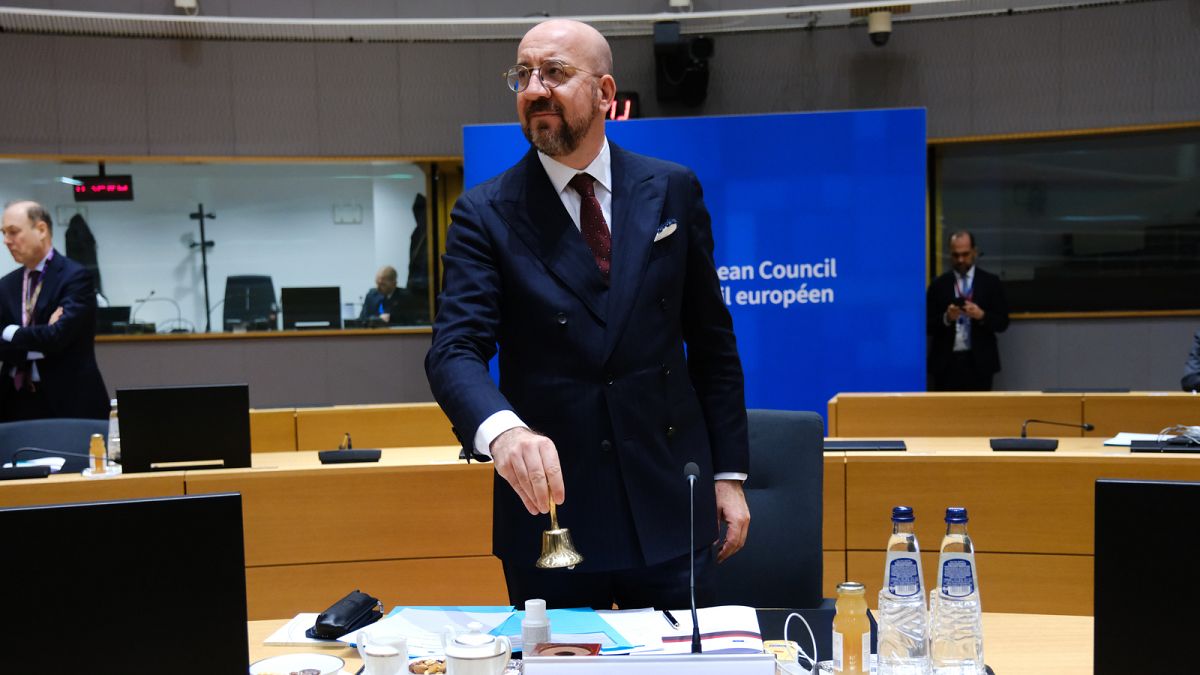
 World1 week ago
World1 week agoEU leaders weigh Lebanon partnership in response to Middle East crisis
-
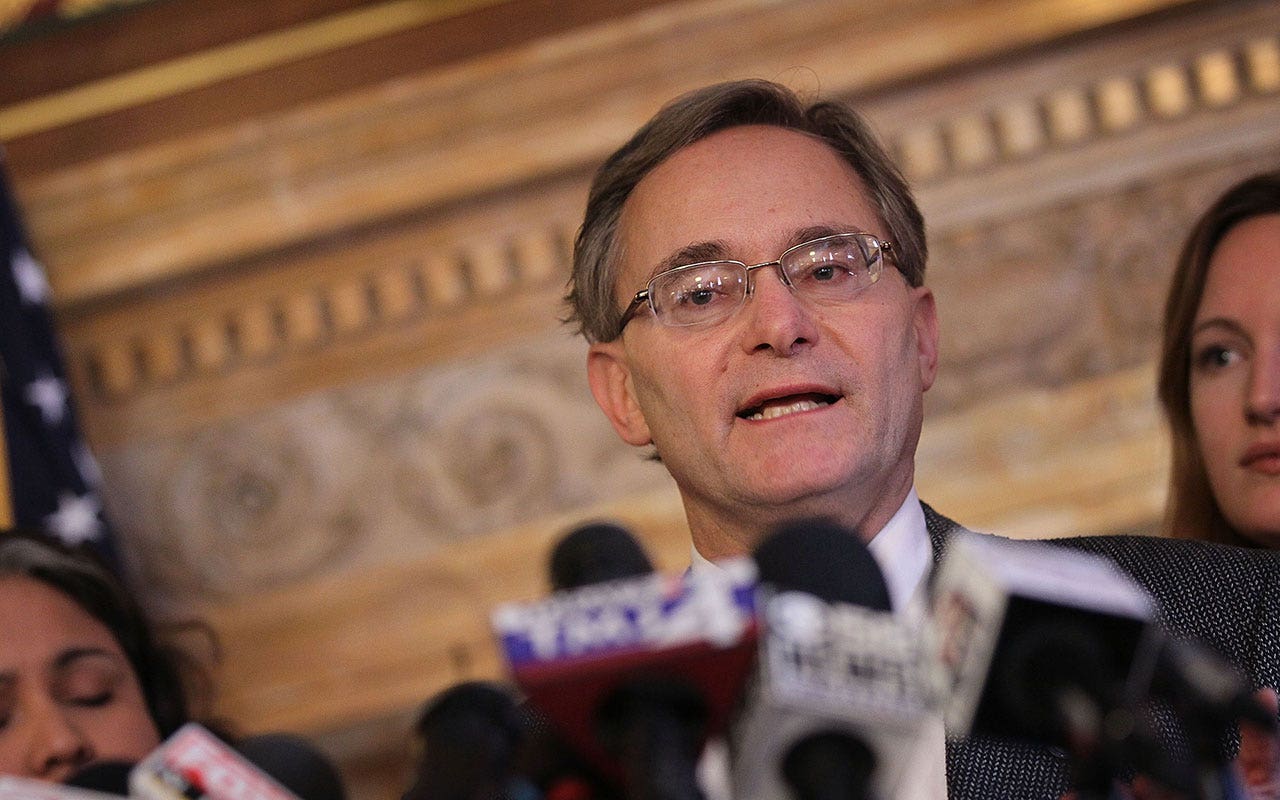
 Politics1 week ago
Politics1 week agoFormer Wisconsin Democratic Rep. Peter Barca launches congressional comeback bid
-
/cdn.vox-cdn.com/uploads/chorus_asset/file/24016887/STK093_Google_02.jpg)
/cdn.vox-cdn.com/uploads/chorus_asset/file/24016887/STK093_Google_02.jpg) Technology1 week ago
Technology1 week agoGoogle fires 28 employees after sit-in protest over Israel cloud contract
-

 World1 week ago
World1 week agoIsraeli attack on nuclear sites to prompt tit-for-tat, pursuing nukes: Iran
-

 News1 week ago
News1 week agoProsecutors say Trump violated gag order 7 times: Live updates
-

 World1 week ago
World1 week agoIranian media says three drones downed after explosions heard in Isfahan
